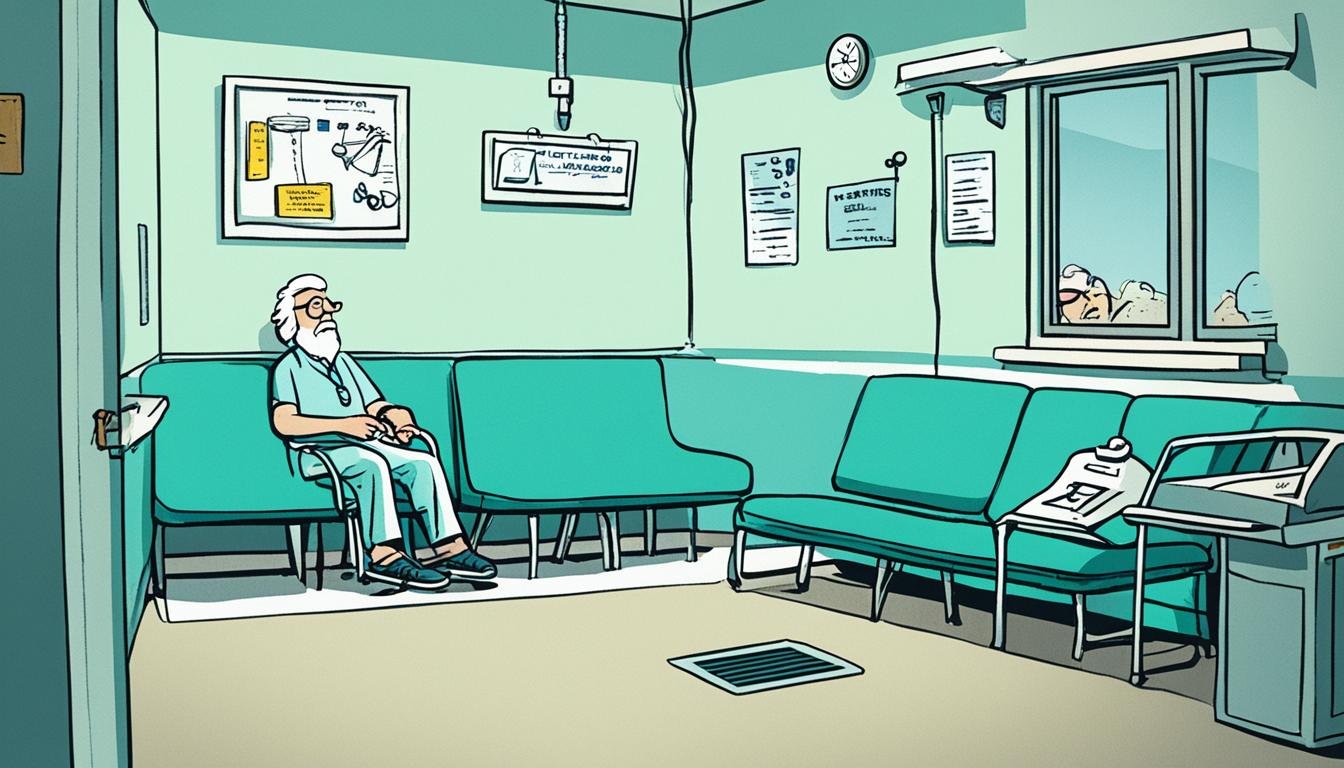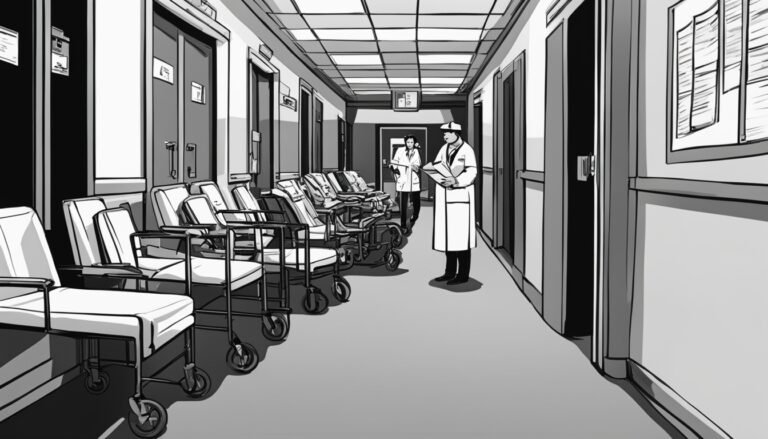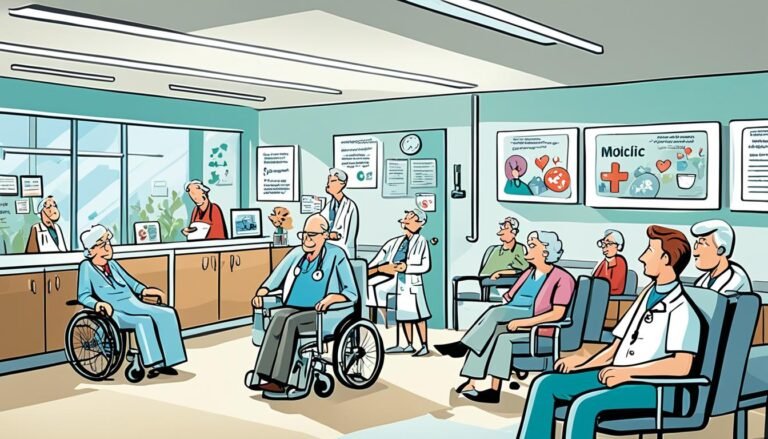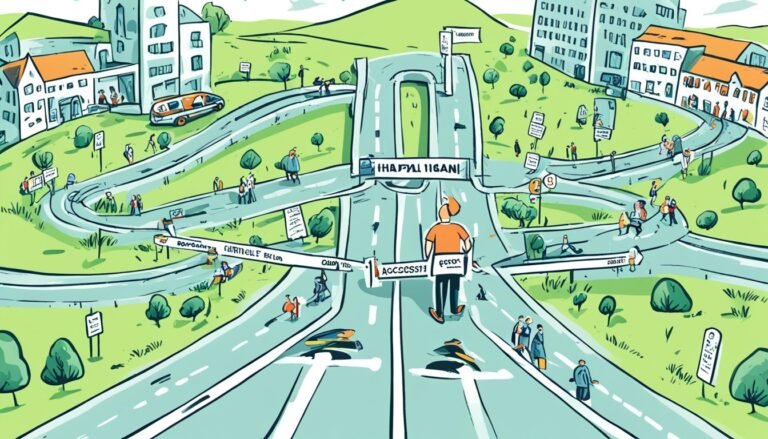Healthcare Accessibility for Rural Populations in Ireland
In 2019, over 37% of Ireland’s people lived in rural areas. This shows a big challenge in giving everyone equal healthcare access. Rural areas often have less access to healthcare than cities.
The first place many go for health care is in rural Ireland. It’s where complex chronic care is often managed. But, there are big differences in getting to healthcare on time in rural areas.
General Practitioners (GPs) are key in primary care. But, there are fewer GPs in rural places. This makes healthcare access even harder in Ireland.
With fewer GPs, getting diagnosed and treated takes longer. This is making health issues worse in rural areas. Rural health services are already overworked and can’t meet the community’s needs.
Fixing these healthcare issues is vital for the health of rural Ireland.
Key Takeaways
- 37% of Ireland’s population resides in rural areas, facing significant healthcare disparities.
- Shortages of General Practitioners (GPs) lead to delayed diagnoses and treatments.
- Primary care coordination is vital for managing complex chronic conditions in rural areas.
- The scarcity of healthcare resources results in strained rural health services.
- Addressing rural healthcare challenges is essential for the overall well-being of these communities.
Introduction to Healthcare Challenges in Rural Ireland
Rural Ireland faces big healthcare challenges, like a lack of GP services and hard access to care. These issues greatly affect the health and wellbeing of those living there. A report shows that healthcare accessibility in rural areas can be measured through a multidimensional framework, as seen by Serban. Roncarolo et al.’s scoping review also points out the needs and challenges in health systems worldwide, focusing on rural health issues.
Rural residents in Ireland deal with many barriers that make getting healthcare hard. Long wait times for appointments and hospital closures due to lack of resources are common. This makes getting the care they need even harder. Rural areas often see hospital closures, making it tough for people to get medical help.
Also, there are fewer primary care services in rural areas than in cities and bigger towns. This means less community support and outreach in rural areas. These differences lead to more rural health problems, as people have to travel far for care. This can cause delays in treatment and worse health outcomes.
Infrastructure issues, like bad terrain and narrow roads, and the lack of public transport, also keep people in rural areas from getting healthcare. This isolation makes it hard for those living there to get the care they need. Studies show that these healthcare challenges in rural areas are a big problem worldwide. This highlights the urgent need to fix these issues in the Ireland healthcare system.
Current State of Rural Healthcare in Ireland
Rural healthcare in Ireland faces big challenges and disparities. Over two-thirds (66%) of GPs in rural areas can’t take on new patients. This shows how hard it is to get healthcare there. For example, in Dublin, you can get an appointment the same day, but in the midlands, it can take up to two weeks for non-urgent care.
Ireland has only seven GPs per 10,000 people, which is less than needed. By 2025, there could be a shortage of 493 to 1,380 GPs, mainly in rural areas. Many GPs are also getting older and might retire soon. In 2022, 442 Irish doctors got work visas for Australia, showing many are leaving the country.
There are big differences in the supply of non-acute care across Ireland. Studies from 2014 show big gaps in primary care, allied health services, and care for older people. These gaps are still there even after adjusting for need. Ireland’s healthcare system focuses too much on hospitals and lacks a full dataset on non-acute services.
The HSE replaced old Health Boards to improve local non-acute services. But, old budgeting ways still cause big differences in healthcare access. For example, rural kids wait up to ten years for dental care, and many didn’t get dental checks last year. There are also fewer dentists for the Dental Treatment Service Scheme.
We need to take action to improve healthcare access and reduce the gap between rural and urban areas. Better data management and national guidance are key to fix these issues. This will help strengthen healthcare in rural areas.
Impact of GP Shortages on Rural Health
Ireland’s rural healthcare system is facing a big challenge due to a lack of GPs. With only seven GPs for every 10,000 people, Ireland falls short of the EU standard. As older doctors retire and more people need primary care, the situation is expected to get worse.
Statistics on GP Shortages
About 25% of Ireland’s population lives in rural areas, but only 15% of GPs work there. Around 600 GPs are close to retiring, which will make things even harder. The HSE and the Irish College of General Practitioners are trying to fix this by bringing in at least 100 doctors from abroad each year.
The General Medical Services (GMS) scheme covers 30% of the population and is the main source of income for GPs, but GPs are now working much harder. This makes it hard for many patients to get the healthcare they need on time.
Government Initiatives
To solve the GP shortage, the government is taking strong steps. They are increasing training spots for new GPs and starting a rural fellowship program. They’re also offering financial incentives to non-EU doctors to work in rural areas, similar to what’s done in other countries to help underserved areas.
The government’s rural healthcare policy aims to set up primary care centers in poor areas. This will help spread out GPs better and make healthcare more accessible to everyone.
Role of Telemedicine in Improving Rural Healthcare Accessibility
Telemedicine is a big step forward for rural healthcare in Ireland. It uses technology to connect patients with doctors from afar. This means people in rural areas can get medical care without leaving home. It’s a big win for health outcomes in these areas.
Current Telemedicine Programs
Ireland has started many telemedicine programs. They offer things like consultations and treatments over the internet. These services are especially helpful for rural folks.
They also train healthcare workers online. This helps them learn how to use telemedicine well.
Challenges and Barriers
Even with its benefits, telemedicine faces some big challenges. One big one is getting reliable internet in rural areas. Another is that some people are slow to accept new ways of getting healthcare.
Not everyone has good internet, which stops some from using telemedicine. People with chronic illnesses or those with private insurance are more likely to use it. But, we need to teach more people about this technology.
Doctors and patients need to get used to it too. Some doctors know a lot about it, but others don’t. So, we need more training for everyone.
The Importance of Mobile Health Clinics
Mobile health clinics are key in helping rural areas in Ireland, like Donegal, get the healthcare they need. These areas often have a spread-out population and not much in the way of healthcare facilities. Mobile health services are a big help in getting care to those who need it.
Mobile health services bring healthcare right to people’s doors. They don’t make patients travel far for care, which is a big deal in rural areas where doctors and specialists are hard to find. For example, in Donegal, mobile units with the right tools have given people quick check-ups and treatments.
There aren’t enough doctors and nurses in rural areas, making it hard to keep up with healthcare needs. Many doctors and nurses move to cities like Dublin, leaving rural areas short-staffed. But, mobile health services can help by using resources well and reaching more people.
Mobile health clinics do more than just meet immediate health needs. They’re part of a bigger plan to make healthcare easier to get. In North America, about 1,500 Mobile Medical Clinics help around 6.5 million people. These clinics have been shown to help people stick to their treatments, like HIV meds, even if they live far from the clinic.
Mobile health services work well with telemedicine, making it easier for people to get care without leaving home. These two together offer a strong solution to the healthcare problems in rural Ireland. By adding mobile health services to the healthcare system, we could greatly improve care for people in rural areas.
Using mobile health clinics is a big step towards making sure everyone can get the healthcare they need. As more groups see the value in these services, we can look forward to a future where everyone gets the care they deserve, no matter where they live.
Community Health Workers: A Vital Resource
Community health workers are key to keeping healthcare going in rural Ireland. They do many things, like giving care that fits each person’s needs and helping coordinate healthcare services. Studies show they make a big difference in health care around the world.
A review looked into what community health workers do and why they’re important. It showed that knowing their roles helps them work better as health support staff. Also, looking at past, present, and future work of programs for these workers shows how crucial they are for reaching health goals.
During the COVID-19 pandemic, a review found that these workers were vital in fighting health gaps. Their work in different countries over time shows they’re effective in many health situations.
Studies on how community health workers help with malaria control show their impact. Their role in improving health in UK primary care also shows how they help in many ways.
Research shows that building trust between community health workers and vulnerable people is key, especially in emergencies. This trust is essential for giving good, culturally aware care.
About 2 billion people in rural areas worldwide don’t have good access to health services. Seeing how important community health workers are, especially in places like Ireland, helps fix these health gaps. There’s still more to learn about these workers in Canada and other rich countries to make their work even better.
Overcoming Healthcare Transportation Barriers
Getting to healthcare in rural areas is hard because of transportation problems. There’s often no public transport, making it tough for people to get to the doctor. This part talks about the transport issues in rural areas and how to fix them to improve healthcare access.
Transportation Issues
Getting to healthcare in rural places is hard because of bad transport. Studies in England and Scotland show that living far from doctors affects health. People in rural areas often don’t survive cancer as long because they have to travel far to get treatment.
Traveling far to get to healthcare means more emergency visits, especially for cancer patients. There are big differences in healthcare access between city and country areas. This leads to different survival rates for things like skin cancer and lung cancer.
Possible Solutions
To fix these transport problems, we can try new ways to get people to healthcare:
- Policy Interventions: The government can help by making transport policies better for rural areas. This would make getting to healthcare easier.
- Improved Transportation Services: Creating reliable and cheap public transport or special medical transport can help rural folks a lot.
- Innovative Mobility Programs: Starting community transport programs or telemedicine can help those who can’t travel far for medical care.
Fixing these transport issues can make healthcare more accessible in rural areas. This means people in rural places can get the health care they need on time. It will lead to better health and less health differences between city and country areas.
Digital Health Solutions for Rural Populations
Digital health in Ireland is growing fast, offering tools for rural areas. It’s key to understand how eHealth strategies and innovation work for rural folks. This helps make these solutions work well and get used more.
Implementation and Adoption
Bringing digital health to rural areas needs a careful plan. A review of 31 papers found big challenges like not having enough tech, language issues, and slow internet. To make eHealth work, we must think about these problems. We also need to help patients who can’t afford tech to use online visits.
Case Studies
Case studies show how digital health changes lives. For example, Walters et al. (2017) found a system that helped older people in primary care feel more independent and happy. Also, Scotland’s quick move to online doctor visits during the pandemic shows the value of being ready. These stories show how the right eHealth strategies and innovation can improve health care for those in remote areas.
Policy Changes and Government Support
Significant policy changes and strong government support in healthcare are key to improving rural healthcare in Ireland. These changes aim to tackle the unique challenges faced by rural areas. They need policies and solutions made just for rural folks.
The Irish government sees the need for quick action. Over two-thirds (66%) of GPs in rural Ireland can’t take on new patients. With only seven GPs for every 10,000 people, we need better strategies.
The Rural Development Policy 2021-2025 sets out a plan to boost rural Ireland with over 150 promises. It plans to increase GP training spots to 350 by 2024 and bring in GPs from other countries. This has already led to the recruitment of 112 GPs through a joint effort.
Spending on general practice jumped from €561 million in 2019 to €784 million in 2022. This shows a big push from the government. Improving digital access, setting up remote work spots, and investing in people and buildings are key parts of healthcare strategy Ireland.
The Central Statistics Office highlights the need for equal service quality in cities and the countryside. Rural areas often have longer trips to get to GPs and pharmacies. The government’s healthcare support aims to close this gap with targeted investments and policies. These efforts focus on making rural healthcare sustainable and viable for the long term.
Innovative Community-Based Health Initiatives
Innovative community-based health initiatives are key in making healthcare more accessible in rural Ireland. They use local resources and knowledge to meet the needs of the community. This approach complements traditional healthcare, using rural health innovation to better deliver care.
These initiatives greatly benefit rural areas where over 1.6 million people live. They tackle the health challenges unique to these areas. The COVID-19 pandemic highlighted the need for flexible, local health programs to improve healthcare access and outcomes.
They also help with the economic challenges of rural life. “Our Rural Future – Rural Development Policy 2021-2025” shows how employment and healthcare are linked in rural areas. By supporting rural health innovation, these programs boost health and local economies.
Access to digital health services is a big part of these initiatives. Digital tools help rural folks join in on remote health programs, overcoming the distance barrier to healthcare. Telemedicine and other digital health tools have changed the game, making sure remote areas get the health care they need.
In short, community-based health initiatives are crucial in closing the gap between traditional healthcare and rural needs. They use local resources, embrace digital health, and offer programs that fit the demographics and economy of rural Ireland.
Conclusion
The future of healthcare in rural Ireland depends on many things. We need to improve healthcare, use new ideas, and make healthcare sustainable. About 42% of Ireland’s people live in rural areas. It’s important to make healthcare easy to get for everyone to have the same health chances.
Things like telemedicine and mobile health clinics are key to helping rural healthcare. These programs are promising but we need to fix some problems to use them fully. Community health workers are very important in building trust and care networks in rural areas.
Government policies and local health projects are vital for rural health care’s future. We need strong policies and more government support to fix issues like not enough GPs and getting to healthcare. By focusing on sustainable healthcare, Ireland can make sure everyone gets better healthcare.
Studies show that health in rural and city areas is not the same. Rural folks often have strong social and family ties and feel healthier living close to nature. But, they face high stress, anxiety, and suicide rates in some areas. To improve, we must use digital health solutions and better healthcare delivery. This will help make rural Ireland healthier and ensure everyone gets the care they need.
Source Links
- The Limerick Declaration on Rural Health Care 2022
- ‘Just lie there and die’: barriers to access and use of general practitioner out-of-hours services for older people in rural Ireland – PubMed
- Improving Rural Healthcare with Collaborative Care Models in NI
- A qualitative study of rural healthcare providers’ views of social, cultural, and programmatic barriers to healthcare access
- Key health issues affecting rural communities
- Dáil Éireann debate – Wednesday, 21 Feb 2024
- Geographic inequalities in non-acute healthcare supply: evidence from Ireland
- Rural GP crisis: Meet the foreign doctors who’ve answered the call
- Impact of decline in GP numbers felt in rural areas
- The distribution of GPs in Ireland in relation to deprivation
- Use of information communication technologies by older people and telemedicine adoption during COVID-19: a longitudinal study
- Telehealth in Primary Health Care: A Scoping Review of the Literature
- Transition to telehealth – Irish Journal of Medical Science (1971 -)
- Navigating the Challenges of Rural Healthcare in Donegal
- Accessibility and utilization patterns of a mobile medical clinic among vulnerable populations
- Access to healthcare for people experiencing homelessness in the UK and Ireland: a scoping review – BMC Health Services Research
- The role of community health workers in primary healthcare in the WHO-EU region: a scoping review
- RRH: Rural and Remote Health article: 7905 – The Limerick Declaration on Rural Health Care 2022
- Original research: Rural and Urban patients’ Requirements and Experiences of Out-of-hours medical care after cancer (RUREO): a questionnaire study
- Addressing the health disadvantage of rural populations: How does epidemiological evidence inform rural health policies and research?
- Telemedicine, e-Health, and Digital Health Equity: A Scoping Review
- Exploring the use of digital technology to deliver healthcare services with explicit consideration of health inequalities in UK settings: A scoping review
- Digital health care across the UK: where are we now?
- Dáil Éireann debate – Wednesday, 21 Feb 2024
- ‘Our Rural Future’ – Rural Development Policy 2021-2025 | Social Justice Ireland
- Patient perspectives on health, health needs, and health care services in a rural Irish community: a qualitative study








